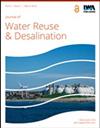Process evaluation of urban river replenished with reclaimed water from a wastewater treatment plant based on the risk of algal bloom and comprehensive acute toxicity
IF 2.3
Q2 Environmental Science
引用次数: 16
Abstract
Municipal wastewater reuse has an important role to play with scarce water resources and serious water pollution. However, the impact of reclaimed water on the aquatic ecology and organisms of the receiving water needs to be assessed. This study investigated one ecological restoration project of an urban river replenished with reclaimed water, and evaluated the risk of algal bloom and acute biological toxicity in the river. Results showed that the concentrations of permanganate index and ammonia nitrogen in the river could stably remain below the standard values, the concentrations of total phosphorus were high and most of the monitoring values were between 0.42 and 0.86 mg/L. The content of chlorophyll a was relatively lower, ranging from 0.06 to 0.10 mg/m3. The maximum value of Fv/Fm was 0.42, which was lower than the algal bloom prediction threshold of 0.63. Moreover, the results of luminescence inhibition rate on luminescent bacteria showed that the reclaimed water did not cause significant biological toxicity to the aquatic ecology. The study suggested that implementing urban reclaimed water reuse projects requires a series of ecological purification and restoration technologies in the receiving water, which can effectively guarantee the stability of water quality and the safety of water ecological environment.基于藻华风险和综合急性毒性的污水处理厂中水回灌城市河流工艺评价
在水资源稀缺、水污染严重的情况下,城市污水回用具有重要意义。然而,再生水对受水的水生生态和生物的影响需要进行评估。本研究以某城市河流中水回灌生态修复工程为研究对象,对该河流发生藻华和急性生物毒性的风险进行了评价。结果表明,河流高锰酸盐指数和氨氮浓度稳定保持在标准值以下,总磷浓度较高,大部分监测值在0.42 ~ 0.86 mg/L之间。叶绿素a含量相对较低,在0.06 ~ 0.10 mg/m3之间。Fv/Fm的最大值为0.42,低于藻华预测阈值0.63。此外,对发光细菌的发光抑制率结果表明,再生水对水生生态没有显著的生物毒性。研究认为,实施城市中水回用工程,需要对受水进行一系列生态净化和修复技术,才能有效保证水质的稳定和水生态环境的安全。
本文章由计算机程序翻译,如有差异,请以英文原文为准。
求助全文
约1分钟内获得全文
求助全文
来源期刊

Journal of Water Reuse and Desalination
ENGINEERING, ENVIRONMENTAL-WATER RESOURCES
CiteScore
4.30
自引率
0.00%
发文量
23
审稿时长
16 weeks
期刊介绍:
Journal of Water Reuse and Desalination publishes refereed review articles, theoretical and experimental research papers, new findings and issues of unplanned and planned reuse. The journal welcomes contributions from developing and developed countries.
 求助内容:
求助内容: 应助结果提醒方式:
应助结果提醒方式:


